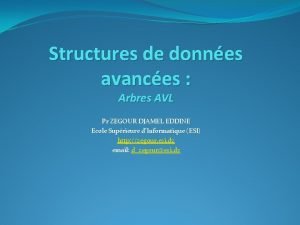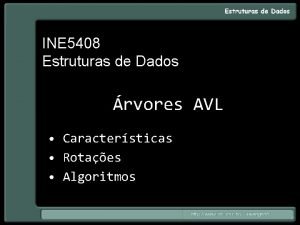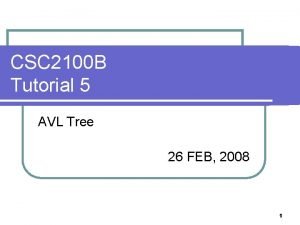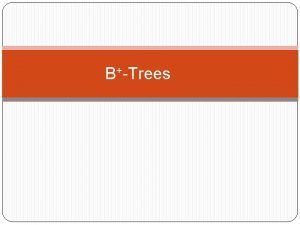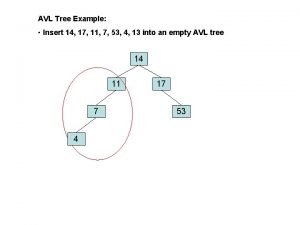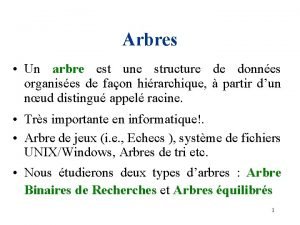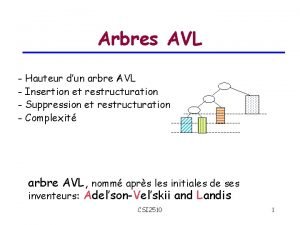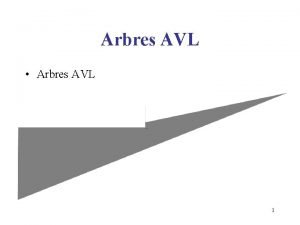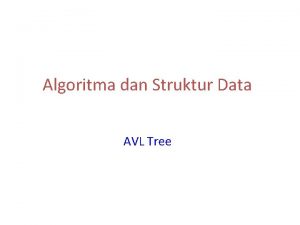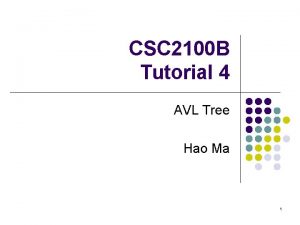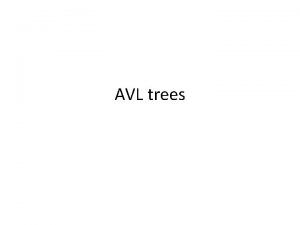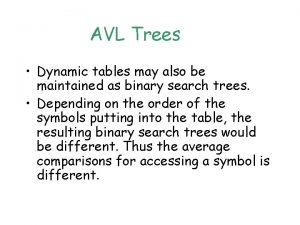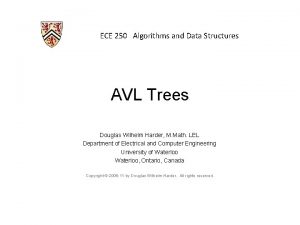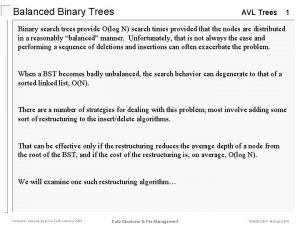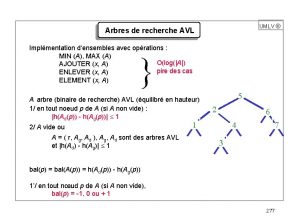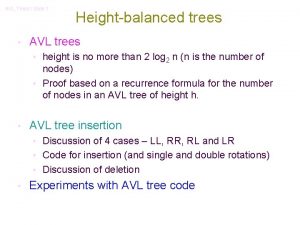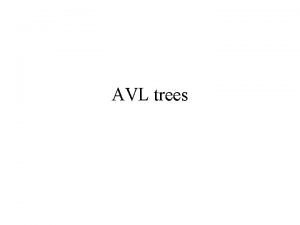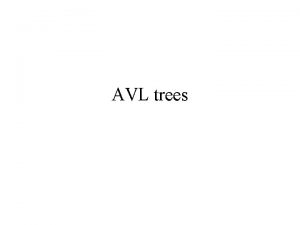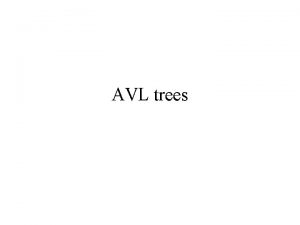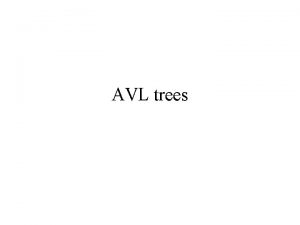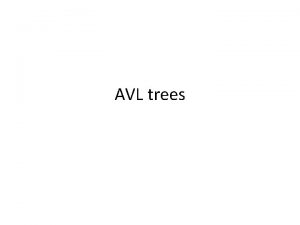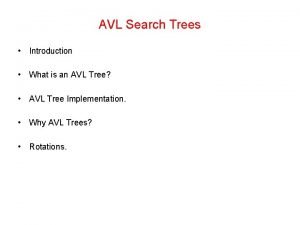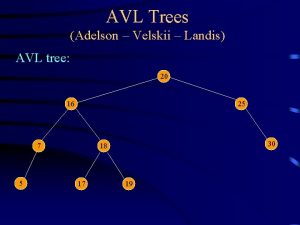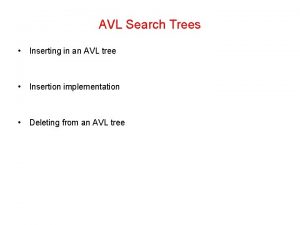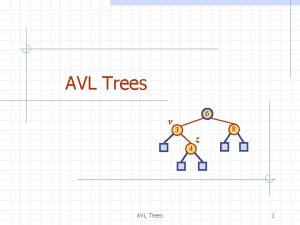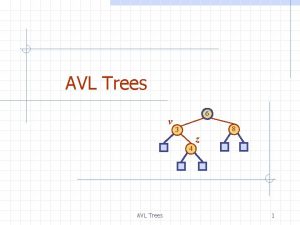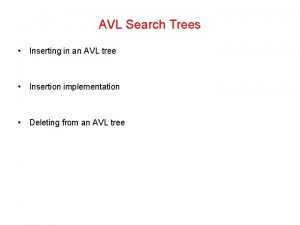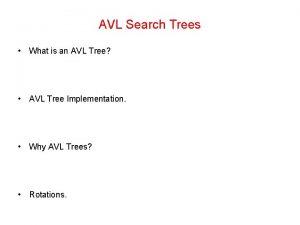AVL Trees n AVL Trees 1 Outline and



























- Slides: 27

AVL Trees n AVL Trees 1

Outline and Reading n AVL tree (§ 9. 2) Definition n Height of an AVL tree n n n Update Operations Java implementation 2

AVL Tree n n AVL trees are balanced. An AVL Tree is a binary search tree such that for every internal node v of T, the heights of the children of v can differ by at most 1. An example of an AVL tree where the heights are shown next to the nodes: 3

Height of an AVL Tree n n n Proposition: The height of an AVL tree T storing n keys is O(log n). Justification: The easiest way to approach this problem is to find n(h): the minimum number of internal nodes of an AVL tree of height h. We see that n(1) = 1 and n(2) = 2 For n ≥ 3, an AVL tree of height h contains the root node, one AVL subtree of height n-1 and the other AVL subtree of height n-2. i. e. n(h) = 1 + n(h-1) + n(h-2) 4

Height of an AVL Tree (cont) n Knowing n(h-1) > n(h-2), we get n(h) > 2 n(h-2) n(h) > 4 n(h-4) n(h) > 8 n(h-6) … n(h) > 2 in(h-2 i) For any integer I such that h-2 i 1 n n n Solving the base case we get: n(h) ≥ 2 h/2 -1 Taking logarithms: h < 2 log n(h) +2 Thus the height of an AVL tree is O(log n) 5

Insertion n n A binary search tree T is called balanced if for every node v, the height of v’s children differ by at most one. Inserting a node into an AVL tree involves performing an expand. External(w) on T, which changes the heights of some of the nodes in T. If an insertion causes T to become unbalanced, we travel up the tree from the newly created node until we find the first node x such that its grandparent z is unbalanced node. Since z became unbalanced by an insertion in the subtree rooted at its child y, height(y) = height(sibling(y)) + 2 Now to rebalance. . . 6

Insertion: rebalancing n n n To rebalance the subtree rooted at z, we must perform a restructuring we rename x, y, and z to a, b, and c based on the order of the nodes in an in-order traversal. z is replaced by b, whose children are now a and c whose children, in turn, consist of the four other subtrees formerly children of x, y, and z. 7

Insertion (contd. ) unbalanced. . . balanced 8

n Restructuring The four ways to rotate nodes in an AVL tree, graphically represented -Single Rotations: 9

n Restructuring (contd. ) double rotations: 10

Restructure Algorithm restructure(x): Input: A node x of a binary search tree T that has both a parent y and a grandparent z Output: Tree T restructured by a rotation (either single or double) involving nodes x, y, and z. 1: Let (a, b, c) be an inorder listing of the nodes x, y, and z, and let (T 0, T 1, T 2, T 3) be an inorder listing of the four subtrees of x, y, and z, not rooted at x, y, or z. 2. Replace the subtree rooted at z with a new subtree rooted at b 3. Let a be the left child of b and let T 0, T 1 be the left and right subtrees of a, respectively. 4. Let c be the right child of b and let T 2, T 3 be the left and right subtrees of c, respectively. 11

Cut/Link Restructure Algorithm n n Let’s go into a little more detail on this algorithm. . . Any tree that needs to be balanced can be grouped into 7 parts: x, y, z, and the 4 trees anchored at the children of those nodes (T 0 -3) 12

Cut/Link Restructure Algorithm n n n Make a new tree which is balanced and put the 7 parts from the old tree into the new tree so that the numbering is still correct when we do an in-order-traversal of the new tree. This works regardless of how the tree is originally unbalanced. Let’s see how it works! 13

Cut/Link Restructure Algorithm n Number the 7 parts by doing an in-order-traversal. (note that x, y, and z are now renamed based upon their order within the traversal) 14

Cut/Link Restructure Algorithm n Now create an Array, numbered 1 to 7 (the 0 th element can be ignored with minimal waste of space) 1 2 3 4 5 6 7 • Cut() the 4 T trees and place them in their inorder rank in the array 1 2 3 4 5 6 7 15

Cut/Link Restructure Algorithm n Now cut x, y, and z in that order (child, parent, grandparent) and place them in their inorder rank in the array. 1 2 3 4 5 6 7 • Now we can re-link these subtrees to the main tree. • Link in rank 4 (b) where the subtree’s root formerly 16

Cut/Link Restructure Algorithm n Link in ranks 2 (a) and 6 (c) as 4’s children. 17

Cut/Link Restructure Algorithm n • Finally, link in ranks 1, 3, 5, and 7 as the children of 2 and 6. Now you have a balanced tree! 18

Cut/Link Restructure algorithm n n This algorithm for restructuring has the exact same effect as using the four rotation cases discussed earlier. Advantages: no case analysis, more elegant Disadvantage: can be more code to write Same time complexity 19

Removal n n We can easily see that performing a remove. Above. External(w) can cause T to become unbalanced. Let z be the first unbalanced node encountered while travelling up the tree from w. Also, let y be the child of z with the larger height, and let x be the child of y with the larger height. We can perform operation restructure(x) to restore balance at the subtree rooted at z. As this restructuring may upset the balance of another node higher in the tree, we must continue checking for balance until the root of T is reached 20

Removal (contd. ) n example of deletion from an AVL tree: Whew, balanced! 21

Removal (contd. ) example of deletion from an AVL tree: Oh no, unbalanced! Whew, balanced! 22

Implementation n A Java-based implementation of an AVL tree requires the following node class: public class AVLItem extends Item { int height; AVLItem(Object k, Object e, int h) { super(k, e); height = h; } public int height () { return height; } public int set. Height(int h) { int old. Height = height; height = h; return old. Height; } } 23

Implementation (contd. ) public class Simple. AVLTree extends Simple. Binary. Search. Tree implements Dictionary { public Simple. AVLTree(Comparator c) { super(c); T = new Restructurable. Node. Binary. Tree(); } private int height(Position p) { if (T. is. External(p)) return 0; else return ((AVLItem) p. element()). height(); } private void set. Height(Position p) { // called only if p is internal ((AVLItem) p. element()). set. Height (1+Math. max(height(T. left. Child(p)), height(T. right. Child(p)))); } 24

Implementation (contd. ) private boolean is. Balanced(Position p) { // test whether node p has balance factor // between -1 and 1 int bf = height(T. left. Child(p)) - height(T. right. Child(p)); return ((-1 <= bf) && (bf <= 1)); } private Position taller. Child(Position p) { // return a child of p with height no // smaller than that of the other child if(height(T. left. Child(p)) >= height(T. right. Child(p)); return T. left. Child(p); else return T. left. Child(p); } 25

Implementation (contd. ) private void rebalance(Position z. Pos) { //traverse the path of T from z. Pos to the root; for each node encountered //recompute its height and perform a rotation if it is unbalanced while (! T. is. Root(z. Pos)) { z. Pos = T. parent(z. Pos); set. Height(z. Pos); if (!is. Balanced(z. Pos)) { // perform a rotation Position x. Pos = taller. Child(z. Pos)); z. Pos = ((Restructurable. Node. Binary. Tree)T). restructure(x. Pos); set. Height(T. left. Child(z. Pos)); set. Height(T. right. Child(z. Pos)); set. Height(z. Pos); }}} 26

Implementation (contd. ) public void insert. Item(Object key, Object element) throws Invalid. Key. Exception { super. insert. Item(key, element); // may throw an Invalid. Key. Exception Position z. Pos = action. Pos; // start at the insertion position T. replace(z. Pos, new AVLItem(key, element, 1)); rebalance(z. Pos); } public Object remove(Object key) throws Invalid. Key. Exception { Object to. Return = super. remove(key); // may throw an Invalid. Key. Exception if (to. Return != NO_SUCH_KEY) { Position z. Pos = action. Pos; // start at the removal position rebalance(z. Pos); } return to. Return; 27 }}
 How to make a sandwich paragraph
How to make a sandwich paragraph One way and two way threaded binary tree
One way and two way threaded binary tree Arbre avl
Arbre avl Simulador avl
Simulador avl Avl tutorial
Avl tutorial Avl tree ll rotation
Avl tree ll rotation Split avl tree
Split avl tree Single rotation in avl tree
Single rotation in avl tree Construct an avl tree
Construct an avl tree Razes avl
Razes avl Arbre avl
Arbre avl Les arbres avl
Les arbres avl Arbre avl
Arbre avl Avl tree flowchart
Avl tree flowchart Avl
Avl Avl tree demo
Avl tree demo Avl delete
Avl delete Avl tree of months
Avl tree of months Binary search
Binary search Alabama virtual libary
Alabama virtual libary Alabama virtual library
Alabama virtual library Tree traversal
Tree traversal Avl-tree
Avl-tree Avl tree maker
Avl tree maker Avl tree
Avl tree Insertion in avl tree
Insertion in avl tree Alberi avl
Alberi avl Avl bal
Avl bal


